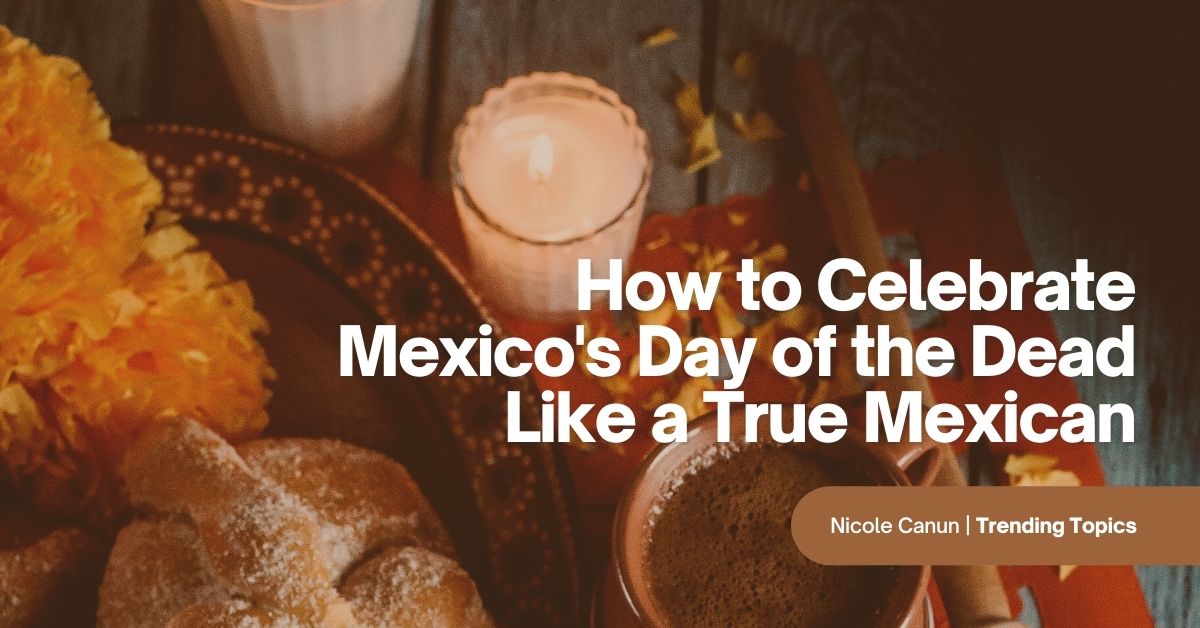
How To Celebrate Mexico’s Day of the Dead Like a True Mexican
Day of the Dead is a Mexican holiday where the living receives their beloved deceased ones in their homes. This tradition has both ancient and colonial roots.
It attracts attention worldwide for “celebrating death.” This is a common misconception. Mexicans do not celebrate death but rather the reunion with their “dead” or muertitos (literally, “the little dead ones).
But, where does this tradition come from? What are the rituals involved? Is it only one day a year? What should you expect from the Day of the Dead for your upcoming trip to Mexico? How can you celebrate it like a true Mexican?
Keep reading to discover the answers to all these questions. Enter a space where magic and the impossible are within reach.
¡Celebremos el Día de Muertos!
Let’s celebrate the Day of the Dead!
Day of the Dead Elements and Rituals
Day of the Dead has many elements and rituals that mix to honor the departed. Decorations, food, poems, pictures, and music all are part of a colorful celebration. Everyone is happy to welcome the spirits after a long journey from the other side.
Altars and Offerings (Altares y ofrendas)
Altars traditionally have two, three or seven levels. The two-level ofrenda represents heaven and Earth. The three levels represent heaven, Earth, and the underworld. The seven-level altar symbolizes the seven steps towards heaven.
These are the items to place on each level, on top of a white blanket representing purity:
- An image of a saint you worship or a cross
- An image of purgatory, a glass of water, a lit candle, and a mirror
- Salt to purify the spirits
- Pan de muerto (bread of the dead)
- Favorite foods and beverages of the dead you are welcoming home
- Pictures of the dead loved ones to whom you are offering the altar
- A cross made of seeds, fruits, a tejocote stick, and lime or ashes so that the spirits can atone their guilt
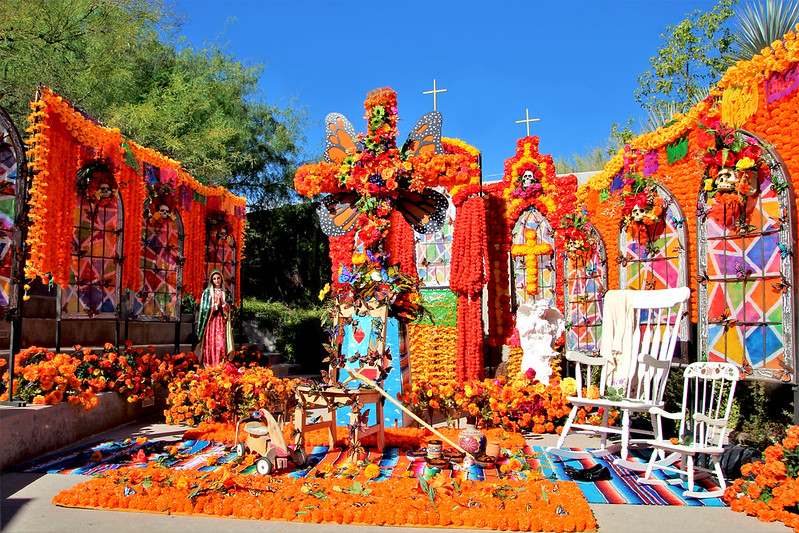
People don’t follow these guidelines strictly. Many people place calaveritas de azúcar y chocolate (sugar and chocolate skulls), incense, or copal to purify the spirits. They may also display belongings that were characteristic of the deceased.
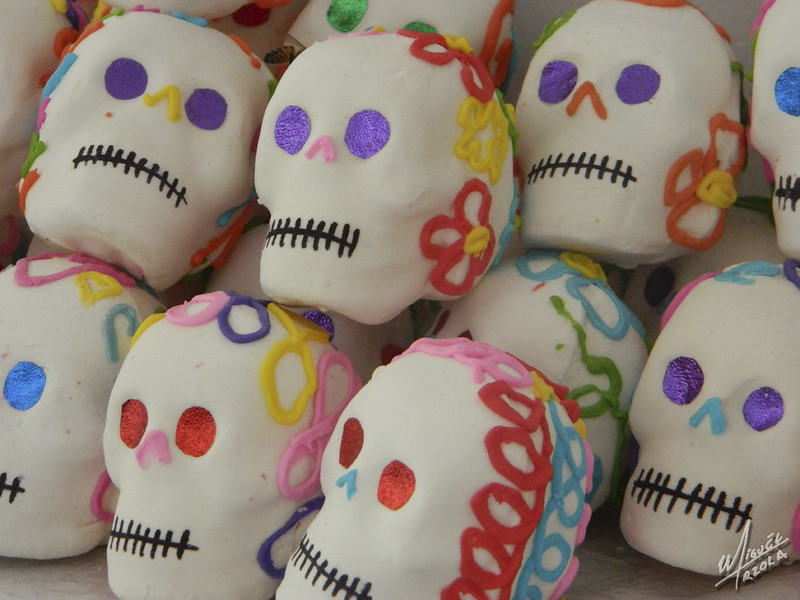
Papel picado (cut-out tissue paper) decorates each level of the altar. These colorful papers feature shapes and figures with Day of the Dead motifs. Hang them from the ceiling in rows to decorate the room.
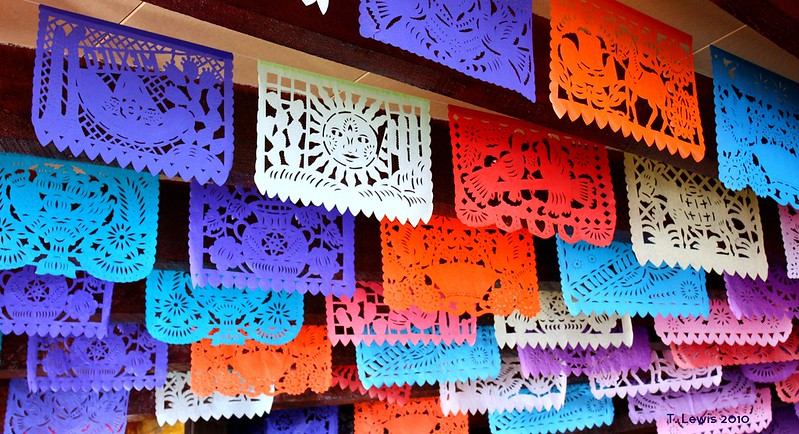
Ofredas include the four elements: Fire in the lit candles light the way for spirits to come and go. Water in glasses lets souls calm their thirst. When the papel picado moves with the wind, it is because a spirit has passed by the altar. The Earth is the sawdust, seeds, and grains on the altar. As we say in Spanish,
Polvo eres y en polvo te convertirás.
Dust you are and dust you shall become.
Music (Música)
Mariachis play the favorite songs of the departed. Music is a key element for a true celebration where the living and the dead are happy to be together. People singing and dancing is what makes you remember you shouldn’t be sad at an event like this.
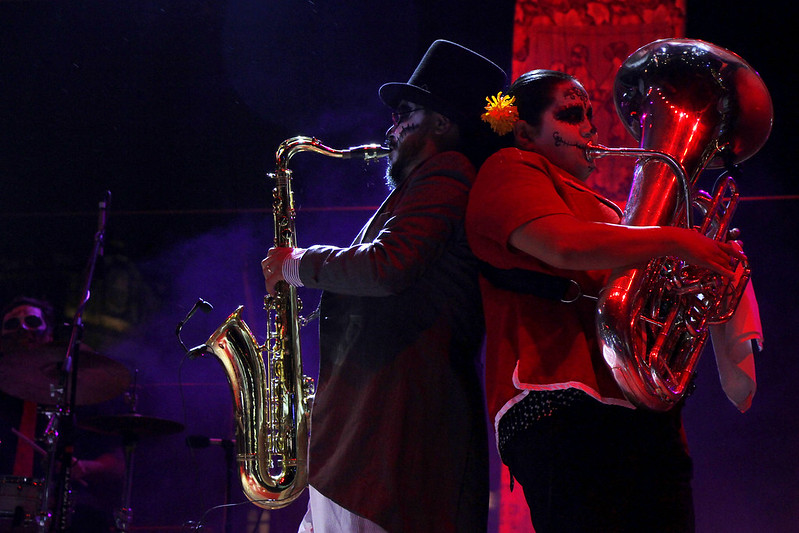
Flowers (Flores)
Day of the Dead flowers are cempasúchil and terciopelo. Terciopelo is a purple flower that symbolizes mourning and grief. It is secondary to cempasúchil, which is an orange-yellow flower that the deceased follow from the other world to our homes and ofrendas.
The color of the cempasúchil represents the sun and light the souls need to see to get here. Sometimes people create an arch made of cempasúchil in their ofrendas, symbolizing the threshold to this world.
Our beloved departed want to come home, eat, drink, sing, and dance with us and to know they are missed, remembered, and loved. The central theme is love and remembrance.
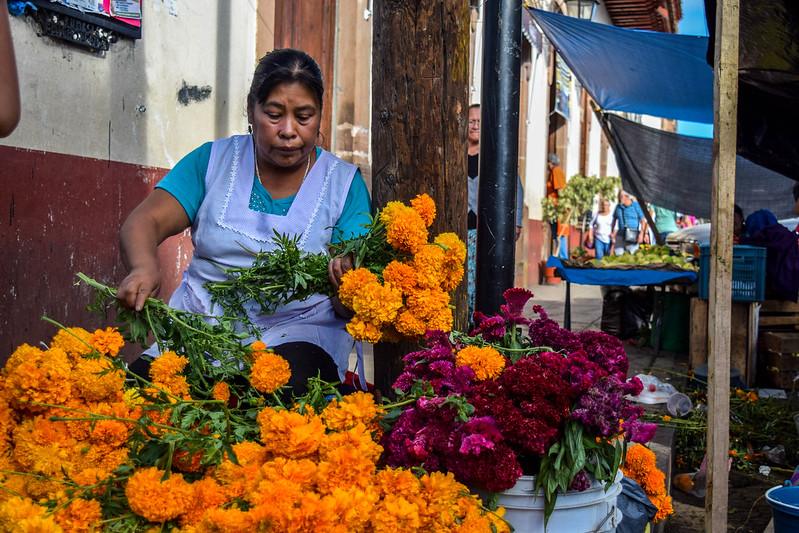
Food (Comida)
The “Bread of the Dead” is the most important and representative food of the holiday. People eat it beginning in October. The most traditional recipe has anise seeds.
Another traditional prehispanic food is calabaza en tacha. This sweet dish is made of pumpkin boiled with sugar, cinnamon, tejocotes, sugar cane, and other ingredients of your choosing.
Dead Rhymes (Calaveritas)
A Calaverita (literally: “little skull”) is a way of making fun—and peace—with death. It is a poem you write to a loved one who is alive explaining the reasons why Death should take them. People publish these funny and satirical verses in the newspaper or share them privately.
Day of the Dead 2021 Celebration Dates and Origin
The Day of the Dead is one of UNESCO’s Intangible Cultural Heritage of Humanity. In Aztec culture, the Day of the Dead occurred in July, October, and March. The Aztecs would dance and eat, make altars, and perform rituals to honor the departed and to help them get to one of the four afterlives.
The criteria for this depended on how the person died (by drowning, in battle, of natural causes, or as a child), unlike the Catholic tradition where you go to heaven or hell depending on your behavior on Earth.
It is difficult to get to Mictlán, the natural death afterlife, so you need the help of a guide, a Xoloitzcuintle or Xoloescuincle, a Mexican dog breed.
When the Spanish arrived, they brought their own celebrations and beliefs, but they did not replace the old ones. The honoring of those who had “raised their shadow”—as Aztecs called it—mixed with the Catholic Night of all Saints (Noche de todos los santos) on November 1 and the Night of the Faithful Departed or All Souls Night (Noche de los fieles difuntos) on November 2.
This combination birthed the Day of the Dead (Día de los Muertos). We call it “day” even though it is a two-day holiday. The official celebration dates are November 1, when Mexicans welcome back dead kids, and November 2 when they receive the dead adults.
Where To Celebrate Day of the Dead in 2021
Most Mexicans celebrate by decorating their houses. In any town square or plaza, you’ll see decorations and dancers, hear live music, and smell the delicious street food stalls.
Here are 4 iconic cities to visit on the Day of the Dead:
Janitzio, Michoacán
The Janitzio Island is a beautiful place in Michoacán where the biggest Day of the Dead celebration takes place. According to a Purepecha legend, the souls fly to the island in the form of monarch butterflies over the enchanted lake. One with an open heart will be able to see those souls.
The view of the cemetery is well worth the trip. Locals adorn every grave with Day of the Dead motifs and candles. From dancing to music and sharing food to invoking the spirits with prayer and sayings in native tongues, this is the most notable destination for Día de los muertos in Mexico.
Míxquic, Mexico City
Travel one hour from downtown Mexico City to Míxquic to see cempasúchil petal paths crossing the town from the local cemetery all the way to people’s homes. People keep their doors open so spirits can come into their houses to the ofrenda.
The local government arranges cultural activities, contests, and concerts. They even stage funeral processions. Many people travel the world just to visit this place in Mexico for Day of the Dead. If you want to see the lit cemetery—which is quite a spectacular show—and the decorations on the graves, come on November 2. As this is a family event, alcohol is prohibited. While you’re there, go to the cemetery church and look at the ceiling. It’s a work of art!
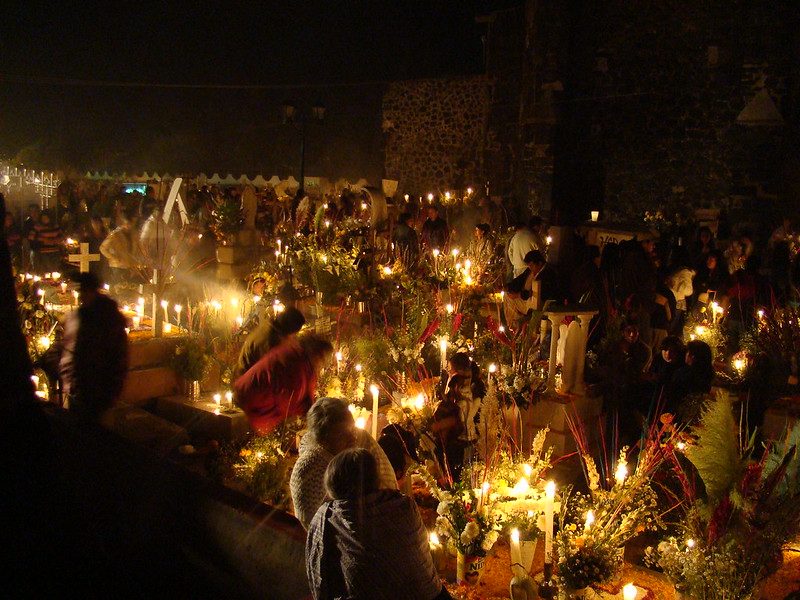
Aguascalientes, Aguascalientes
People from Aguascalientes celebrate each year the “Skull Festival” or Festival de las calaveras where everything has traces of the work of local artist José Guadalupe Posada.
There are cultural activities for all tastes and ages, including a giant parade and hike. What you can’t miss is the living ofrenda, where people dress up and dance on top of a life-size altar. This is one of the most contemporary and modern celebrations. When you visit any cemetery, you’ll find mariachis, food, drinks, dancers, and storytellers.
San Antonio, Texas
If you can’t make it to Mexico this year, enjoy the colorful Day of the Dead celebration in San Antonio, Texas. This annual festival happens downtown on the Riverwalk. Witness Mexican chinampas (small river barges) decorated with cempasúchil. Visit the ofrenda to Frida Kahlo and be part of one of the best fall festivals in the United States according to National Geographic.
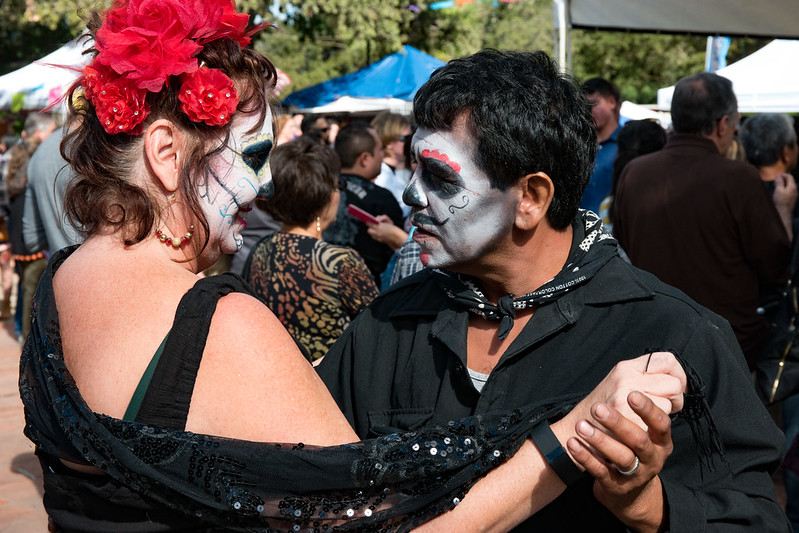
How To Dress on the Day of the Dead
Don’t miss the opportunity to wear Mexican traditional clothes and regional costumes, or as a catrina or catrín, if you want the full Day of the Dead experience.
What is a catrina or catrín? These figures are the most famous of the Day of the Dead celebrations. José Guadalupe Posada created them to satirize Mexico’s upper class and criticize their frivolous and ignorant ways of living. The catrín is in a tuxedo and has a top hat. The catrina wears big dresses, jewels, and feather hats.
Today, many women use Oaxacan huipil or regional dress and decorate their heads with big paper mache flowers.
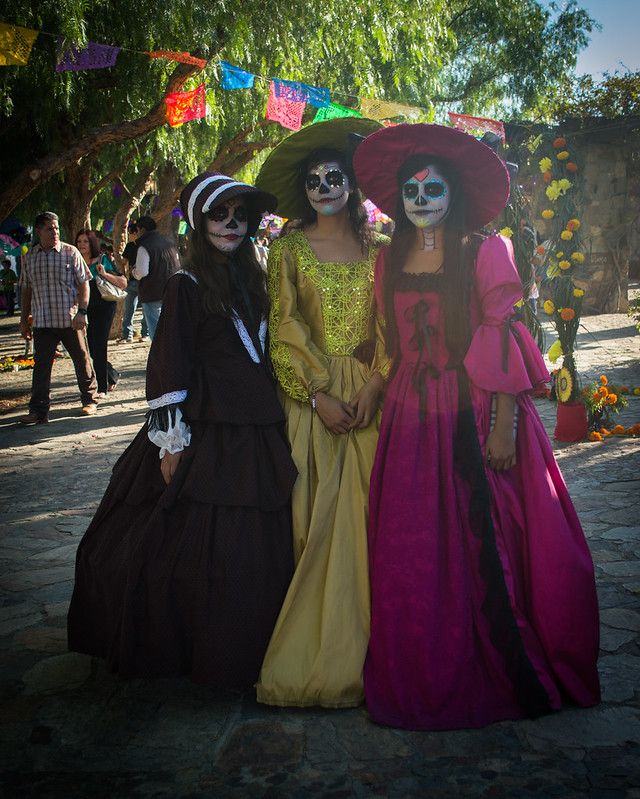
How To Teach Day of the Dead to Children
This can be a specially fun celebration for kids. Explain the traditions and the symbols of this holiday to them. They love to get dressed up in Day of the Dead costumes, have their faces painted, and have their hair braided with flowers. Also, if they have experienced the passing of a close family member or friend they can feel some ease knowing they can still be with them one day every year.
By watching the Disney movie, Coco, your child will learn about alebrijes (spirit guides with body parts of different animals), the importance of cempasúchil, pictures of our muertitos, and what happens if you take something from the ofrendas (don’t!). Get closer to Mexican culture by learning the songs from the movie.
Honor Mexican Traditions by Learning Spanish
Mexican culture and traditions are fascinating and unique, which is why many travelers come to Mexico. Delicious food, cheerful music, colorful decorations, and kind people are only some of the things you can find here.
By learning Spanish, you open the doors to Hispanic culture, literature, music, and more. You’ll be able to talk with native Spanish speakers, share thoughts and ideas, and even become lifelong friends.
One of the best methods to learn Spanish is to hold conversations with a native speaker. Here at Homeschool Spanish Academy, we offer Spanish packages tailored to your needs and interests. Become part of our community of more than 24,000 monthly enrolled students and trust our decade of experience in teaching people to speak this beautiful language. Let our friendly teachers from Guatemala help you—sign up today for a free trial class!

Ready to learn more about Mexico and Latin America? Check these out!
- Celebrating Culture and Joy: The Magic of Carnival in Spanish-Speaking Countries
- 15 Mouth-Watering National Dishes of Latin America
- Discovering The Mayan Languages
- The 10 Most Common Spanish Surnames in The U.S
- Everything About Mexican Christmas Traditions
- What Is the Hispanic Scholarship Fund? Is It Legit?
- A Spanish Guide to Thanksgiving Food Vocabulary
- How Did All Saints Day Celebrations Started?
- Car Parts Spanish Vocabulary List: Learn Using Pictures - February 1, 2024
- Discovering The Mayan Languages - January 4, 2024
- The 10 Most Common Spanish Surnames in The U.S - December 28, 2023




